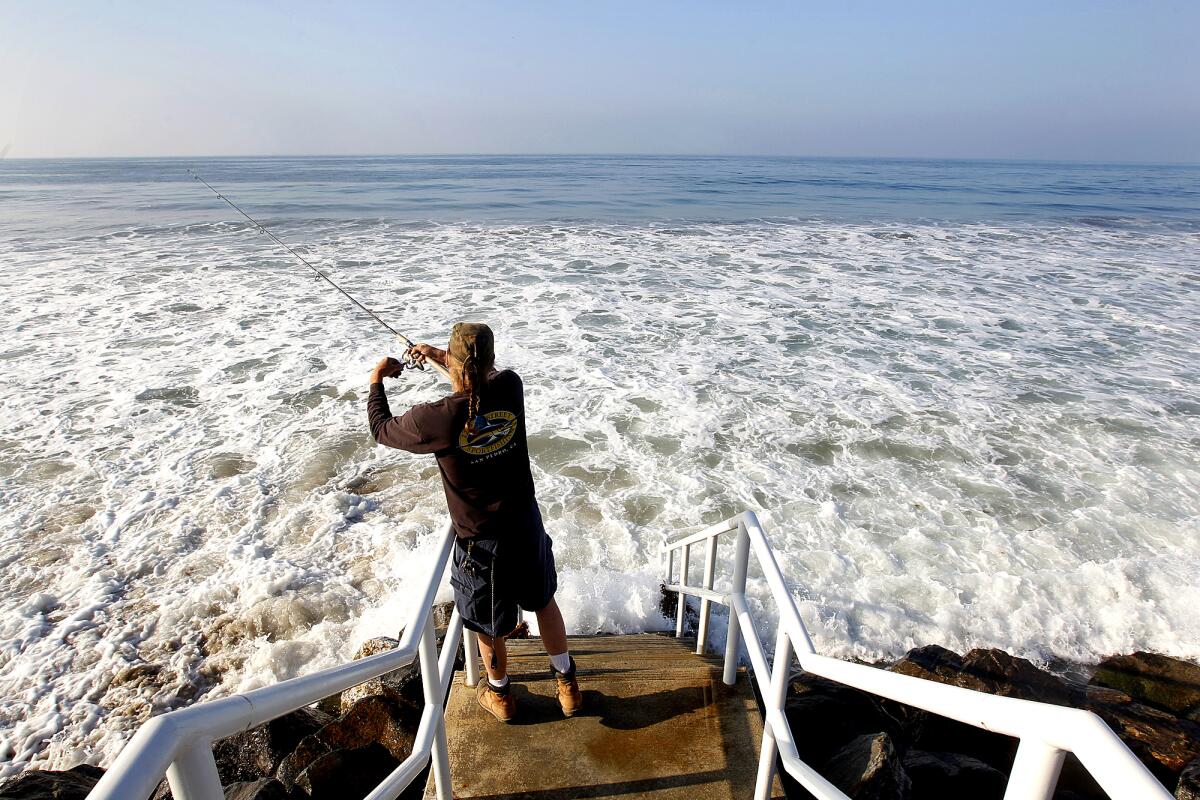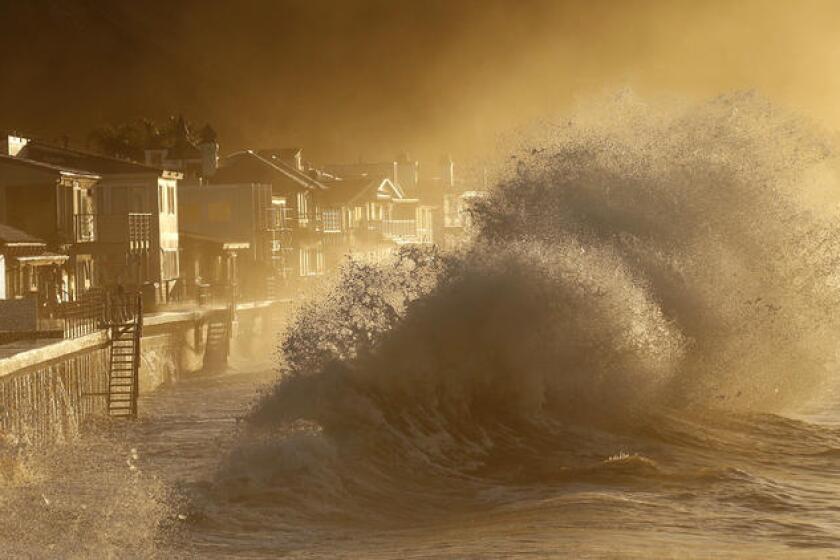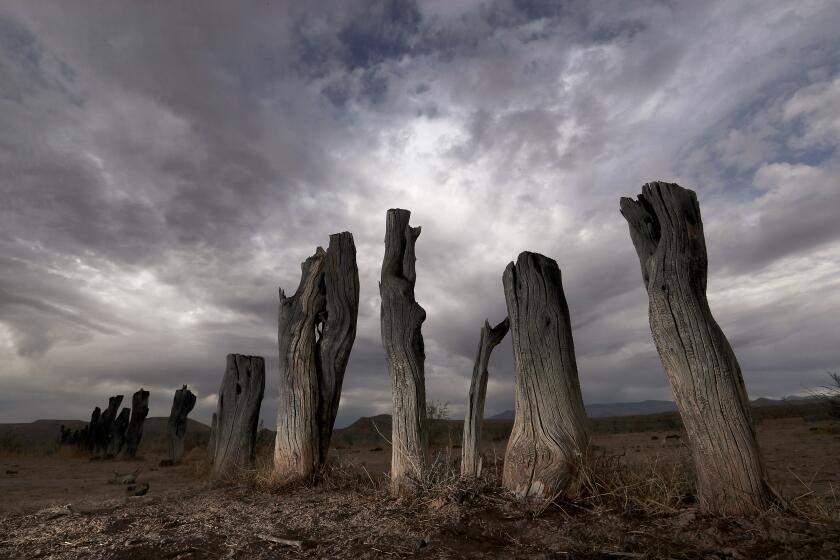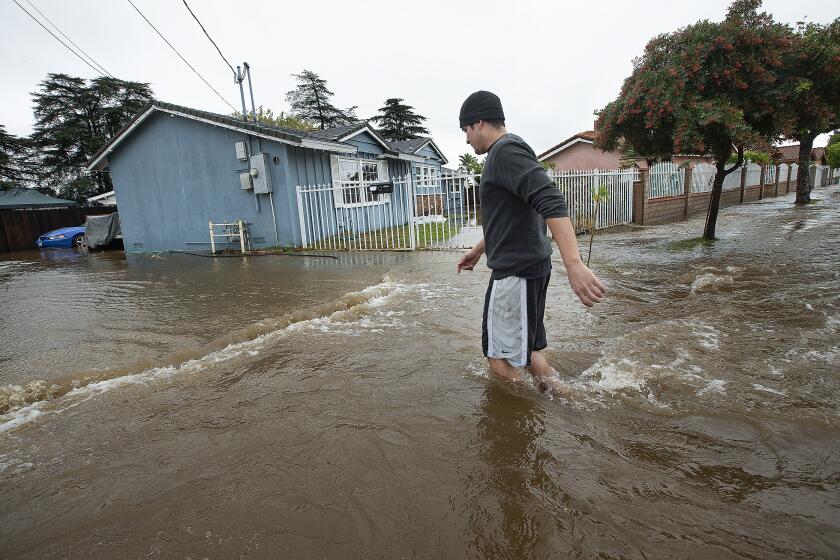Rising sea levels pose perilous threat to California coast as study raises new alarms

- Share via
Los Angeles and other coastal areas of the United States will experience frequent flooding, degraded infrastructure and other profound challenges as sea levels rise by as much as 1 foot by 2050, a federal study released Tuesday found.
The report outlines an alarming new future for communities, ecosystems and economies along the nation’s seaboard, and predicts that the U.S. coastline will experience as much sea level rise in the next 30 years as it did in the last hundred years.
“It is eye-opening – thirty years, 2050, is not that far away,” said Ben Hamlington, a research scientist at NASA’s Jet Propulsion Laboratory in La Cañada Flintridge and one of the report’s lead authors.
Researchers found the United States coastline will see, on average, 10 to 12 inches of sea level rise by 2050. On the West Coast, the anticipated rise will be as high as 8 inches.
Although a foot of sea level rise may not sound like much to some people, it would contribute to a significant increase in the frequency of coastal flooding — even in the absence of storms or heavy rainfall, researchers said.
The two primary causes for sea level rise are the expansion of ocean water as it warms, and the melting of ice sheets and glaciers, according to the report. Both processes are driven by increased global temperatures associated with fossil fuels and greenhouse gas emissions.
“One of the first ways we’ll feel that 10 inches is through high tide, or nuisance, flooding,” Hamlington said, noting that West Coast communities that already occasionally see flooding during king tides will soon be subject to a new kind of “flooding regime,” where even small tides will send ocean water ashore.
Even regular El Niño events off the West Coast, which are already associated with higher sea levels, will be piled atop that higher foundation.
“As much as anywhere, here on the West Coast our sea level rise is very closely attached to global warming,” Hamlington said.
The prospect that California’s sea level rise will meet with Western megadrought conditions only adds to the area’s uniquely precarious position.
Though the drought and rising seas are not directly connected, “they’re both consequences and negative impacts that we expect to see with global warming,” he said.
Scientists are seeing changes off Alaska that have never been documented before, as warming upsets a vast ecosystem and one of the world’s vital fisheries.
The report, which updates federal sea level projections from 2017, was led by researchers with the National Oceanic and Atmospheric Administration, NASA, the U.S. Geological Survey and other government agencies. Together, they emphasized that sea level rise driven by global climate change already poses a “clear and present risk” to the nation, and will continue to worsen in the decades and centuries to come without immediate action.
Researchers used tide gauges, satellite observations and computer modeling to narrow in on sea level rise predictions with increasing precision, they said.
“This report is a wake-up call for the United States,” NOAA Administrator Rick Spinrad told reporters. “It’s a wake-up call that comes with a silver lining: It provides us with information needed to act now to best position ourselves for the future.”
Tens of millions of people in the United States and hundreds of millions of people globally live in areas that are at risk of coastal flooding.
The East Coast could see as much as 14 inches of sea level rise by 2050, and the Gulf Coast as much as 18 inches, according to the report, with regional variabilities primarily attributed to land height changes.
What’s more, sea level rise “does not act alone,” the researchers said. Sinking lands, storm surges, wave affects and other coastal flood factors will combine to significantly increase the exposure of communities along the coast.
Moderate flooding, which can already be damaging and disruptive by today’s standards, is expected to occur 10 times more often by 2050 than it does today, according to NOAA National Ocean Service Director Nicole LeBoeuf.
The West is experiencing its most severe megadrought in a millennium, according to a new study. Scientists say climate change is playing a major role.
The rising seas also pose a critical risk to infrastructure such as roads, water supplies, power plants, oil and gas wells and sewage treatment systems, and nearly “everything that we use, eat and wear” that comes through the supply chain and arrives through coastal ports, LeBoeuf said during the news conference.
“The magnitude of these impacts, direct and cascading, will be high,” she said, noting that 40% of the U.S. population lives within 60 miles of the shore. “There will be highly variable impacts along those coastlines, but there’s no denying that a large portion of our economy and revenue and tax base are right there, front and center.”
In California, the impacts could be acute: Daily overland flooding from one foot of sea level rise equates to about $15 billion worth of properties at risk and would affect about 38,000 people, according to Patrick Barnard, a USGS research geologist who also worked on the report.
The daily emergence of groundwater pushed up by the rising seas could also expose an additional 350,000 people and $100 billion worth of properties, he said.
“There’s definitely a lot of low-lying communities that have seasonal or annual high tide flooding today,” Barnard said. Venice, Seal Beach, Newport and parts of Huntington Beach are all examples. “They’re already sort of on that knife-edge, and another foot of sea level rise is going to increase the frequency of flooding of those communities.”
Coastal erosion — already a concern in California, Louisiana and South Florida — will also intensify as waters rise, eating away at seaside cliffs, threatening local real estate and forever altering ecosystems and shorelines.
Barnard said it’s hard to envision urban coastal areas like Los Angeles retreating entirely, but “it definitely will be more costly to defend the coast, and more costly to keep beaches around.”
And while some residents may choose to relocate, many of the communities most vulnerable to coastal flooding and other climate change hazards are low-income communities with limited mobility, according to a separate report from Los Angeles County, which was published at the end of last year.
A new county report lays bare how social and economic inequality have left millions of local residents vulnerable as the climate crisis heats up.
The response to rising sea levels increasingly involves adaptation and mitigation in addition to prevention. Sea levels will continue to rise in the coming decades and centuries even if global emissions and temperatures are reduced, the latest report says. That’s largely because of the ocean’s sustained response to the warming that has already occurred.
But that doesn’t mean all hope is lost. While the projections for 2050 are more certain, the researchers said reductions in current and future emissions could still alter the amount of sea level rise in the future.
“Failing to curb future emissions could cause even greater impacts to Americans,” Spinrad told reporters.
Specifically, failing to curb future emissions could cause an additional 1.5 to 5 feet of rise by 2100, according to the report.
Even greater sea level rise is possible if global warming rises above 5.5 degrees because of the rapid melting of ice sheets. The NOAA last year found the planet’s average land and ocean surface temperature was 1.51 degrees higher than the 20th century average.
“It’s important to underscore that this report supports previous studies and confirms what we’ve known all along, and that’s that sea levels are continuing to rise at a very alarming rate, and it’s endangering communities around the world,” NASA Administrator Bill Nelson said.
The researchers hoped that their findings would provide a foundation for an urgent and proportionate response.
Barnard, of the USGS, said California is in many ways ahead of the curve when it comes to looking at the projections and developing policy guidance, while Hamlington, of JPL, said some policy-makers and related groups in the state have already reached out about incorporating their work.
“This does highlight the immediacy of the problem,” Hamlington said, “both in terms of the sea level rise we expect to see and the flooding that we expect to result.”
More to Read
Sign up for Essential California
The most important California stories and recommendations in your inbox every morning.
You may occasionally receive promotional content from the Los Angeles Times.















